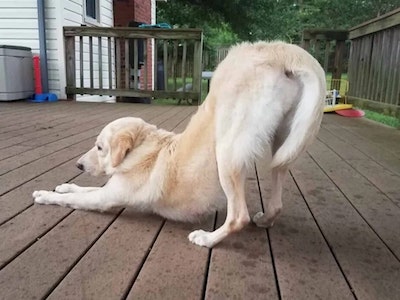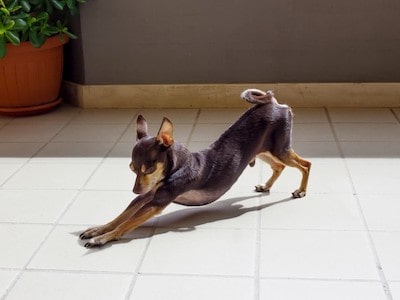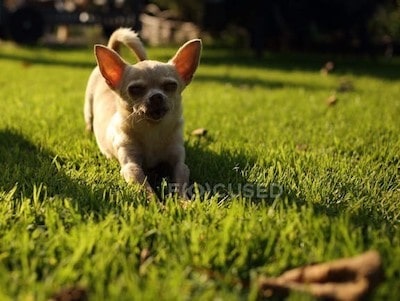If you’ve ever wondered why your furry friend engages in those adorable, seemingly excessive stretches, you’re in the right place. It turns out there’s more to those stretchy antics than meets the eye. In this article, we will delve into the fascinating world of canine stretching, exploring the reasons behind this common behavior.

From their physical well-being to their emotional state, there are various factors that contribute to why dogs stretch so much. So, get ready to stretch your knowledge as we unravel the mystery behind our canine companions’ stretching habits.
Whether you’re a dog owner, a dog lover, or simply curious about our four-legged friends, this article will provide valuable insights into the intriguing question, “Why does my dog stretch so much?”
So, let’s dive in and discover the secrets behind those adorable stretches!
Table of Contents
What is Stretching and Why Do Dogs Do It?
Stretching is the act of extending or lengthening a body part, such as a limb, a muscle, or a joint. Stretching can help improve flexibility, mobility, circulation, and relaxation. Stretching can also relieve tension, pain, stiffness, and stress.

Dogs stretch for similar reasons as humans do. They stretch to loosen up their muscles and joints after sleeping, resting, or sitting for a long time. They stretch to prepare their bodies for physical activity, such as running, playing, or jumping.
They stretch to express their emotions, such as happiness, excitement, or curiosity. They stretch to communicate with other dogs or humans, such as inviting them to play or showing submission.
Reasons Why Dogs Stretch so Much
Dogs stretch for various reasons, depending on their physical and emotional state, as well as their environment and situation. Here are some of the most common reasons why dogs stretch so much:
Your dog is tired
One of the most obvious reasons why dogs stretch is because they are tired. Stretching helps them relax their muscles and joints after a long nap or a hard day of activity. It also helps them wake up and prepare for the next adventure.
Dogs typically stretch when they get up in the morning, after taking a nap, or before going to bed. They may also stretch after playing, running, or exercising. Stretching helps them release any tension or stiffness in their body, and prevent any injuries or soreness.
Your dog is not exercising enough
Another reason why dogs stretch is because they are not exercising enough. Stretching helps them release tension and stiffness in their body due to lack of movement or stimulation. It also helps them maintain their flexibility and mobility, and prevent any muscle atrophy or joint problems.
Dogs need regular exercise to stay healthy and happy. Exercise helps them burn calories, strengthen their muscles and bones, improve their cardiovascular and respiratory systems, and stimulate their brain and senses. Exercise also helps them release excess energy, reduce stress and anxiety, and prevent boredom and behavioral issues.
If your dog is not getting enough exercise, they may stretch more frequently or excessively to compensate for their lack of activity. They may also show signs of restlessness, frustration, or depression, such as pacing, whining, barking, chewing, digging, or escaping.

Your dog has an upset stomach
A less common but possible reason why dogs stretch is because they have an upset stomach. Stretching helps them relieve bloating or gas buildup in their digestive system that causes discomfort or pain. It also helps them stimulate their bowel movements and ease constipation or diarrhea.
Dogs can have an upset stomach due to various factors, such as eating something spoiled or toxic, swallowing a foreign object, having a food allergy or intolerance, having a parasite or infection, or having a chronic condition such as inflammatory bowel disease (IBD) or pancreatitis.
If your dog has an upset stomach, they may stretch more often or intensely to try to ease their symptoms. They may also show signs of nausea, vomiting, loss of appetite, abdominal pain or swelling, or blood in their stool.
Your dog is showing submission
Another reason why dogs stretch is because they are showing submission. Stretching helps them communicate deference or appeasement to other dogs or humans. It also helps them avoid conflict or aggression by signaling that they are not a threat or a challenge.
Dogs are social animals that live in hierarchical groups. They use body language to express their emotions and intentions to each other. Stretching is one of the ways that dogs show submission to a higher-ranking member of the group, such as the alpha dog or the owner.
If your dog is showing submission, they may stretch in front of another dog or human that they respect or fear. They may also lower their head, tuck their tail, lick their lips, yawn, or roll over on their back.
Your dog is displaying mating behavior
Another reason why dogs stretch is because they are displaying mating behavior. Stretching helps them attract or invite potential mates or signal readiness to mate. It also helps them prepare their body for reproduction by increasing blood flow and lubrication.
Dogs typically display mating behavior when they are in heat (estrus) or when they sense another dog in heat nearby. Mating behavior can vary depending on the gender, breed, age, and personality of the dog.
If your dog is displaying mating behavior, they may stretch in front of another dog that they are interested in or that is interested in them. They may also raise their tail, expose their genitals, wag their tail, or mount another dog or object.
Your dog feels good
One of the simplest reasons why dogs stretch is because they feel good. Stretching helps them stimulate their nervous system and release endorphins that create a sense of well-being and happiness. It also helps them express their emotions and personality by showing their contentment and satisfaction.
Dogs typically stretch when they are happy and relaxed, such as after a meal, a massage, or a cuddle session. They may also stretch when they are excited or curious, such as before a walk, a car ride, or a new experience. Stretching helps them enjoy the moment and share their joy with others.
Your dog wants to play
Another reason why dogs stretch is because they want to play. Stretching helps them initiate or engage in playful interactions with other dogs or humans. It also helps them show their friendliness and enthusiasm by inviting others to join them in the fun.
Dogs typically stretch when they are playful and energetic, such as after waking up, before going outside, or during playtime. They may also stretch when they are bored or lonely, such as when they are left alone, confined, or ignored. Stretching helps them attract attention and stimulate their mind and body.
The Benefits of Stretching for Dogs
Stretching your dog regularly can have many positive effects on their health and well-being. Some of the benefits of stretching your dog are:

- Keeps muscles supple and flexible
- Boosts circulation
- Increases oxygenation and hydration
- Enhances dog/person bond
- Engenders feelings of calm and contentment
Movement is how a dog’s body heals. Dogs can maintain and even improve mobility and range of motion of the joints with just a few minutes of stretching and massage each day. Stretching can also help prevent or reduce joint pain, arthritis, muscle atrophy, nerve impingement, and injuries.
The types of stretches dogs do and what they mean
Dogs have different ways of stretching their bodies, depending on their needs and intentions. Some of the most common types of stretches dogs do are:
- The play bow: This is when a dog lowers their front legs and chest to the ground while keeping their rear end up in the air. This is a sign of playfulness and invitation to play. It can also be a way of saying sorry or appeasing another dog or human.
- The downward dog: This is when a dog stretches their front legs forward while pushing their rear end up in the air. This is similar to the yoga pose with the same name. This is a way of stretching the spine, shoulders, chest, and legs. It can also be a sign of relaxation or happiness.

- The upward dog: This is when a dog lies on their belly and lifts their head and chest up while extending their rear legs behind them. This is another yoga pose that dogs do naturally. This is a way of stretching the abdomen, back, neck, and hips. It can also be a sign of confidence or curiosity.
- The back leg stretch: This is when a dog extends one or both of their rear legs behind them while standing or lying down. This is a way of stretching the hips, lower back, and legs. It can also be a sign of comfort or contentment.
When Stretching Is a Sign of Trouble
While stretching is usually a healthy and normal behavior for dogs, sometimes it can indicate that something is wrong. If your dog stretches excessively or abnormally, it may be a sign of an underlying problem that needs attention. Some of the possible causes of abnormal stretching are:
1) Upset stomach: If your dog stretches frequently while making gurgling sounds or licking their lips, they may have digestive issues such as gas, bloating, nausea, or indigestion. This can be caused by eating something bad, having food allergies or intolerances, or having parasites or infections.
You can help your dog by giving them probiotics, digestive enzymes, or plain yogurt. You can also consult your vet for diagnosis and treatment.
2) Female dogs that haven’t been fixed: If your female dog hasn’t been spayed yet, they may stretch in a way that resembles mating posture when they are in heat.
This is when they lower their front end to the ground while raising their rear end and tail to expose their genitals. This is a way of signaling their readiness to mate to male dogs.
You can prevent this by spaying your female dog before they reach sexual maturity.

3) Splooting: This is when a dog lies on their belly with their front legs stretched forward and their rear legs stretched sideways. This is not necessarily a sign of trouble, but rather a preference for some dogs who find this position comfortable and cool.
However, some breeds such as corgis and bulldogs may be more prone to splooting due to their short legs and long bodies. This can put pressure on their spine and hips and cause pain or injury over time.
You can help your dog by providing them with soft and supportive bedding, avoiding hard and slippery surfaces, and limiting their jumping and climbing activities.
4) Stretching while dragging hind legs: This is when a dog stretches their front legs forward while dragging their rear legs behind them. This can be a sign of a serious condition such as degenerative myelopathy, intervertebral disc disease, spinal cord injury, or hip dysplasia.
These conditions can affect the dog’s nerve function and cause weakness, paralysis, or pain in their hind legs. You should take your dog to the vet immediately if you notice this behavior.
FAQ
Is excessive stretching a cause for concern?
In most cases, excessive stretching is not a cause for concern. Dogs, like humans, have their own stretching routines and preferences. However, if you notice a sudden change in your dog’s stretching behavior accompanied by signs of discomfort, pain, or limping, it is advisable to consult a veterinarian to rule out any underlying health issues.
Are certain dog breeds more prone to stretching?
While all dogs stretch to some extent, certain breeds may exhibit more stretching behavior than others. Breeds that are known for being active and agile, such as Greyhounds, Border Collies, and Boxers, may engage in more frequent and elaborate stretching routines. However, it’s important to remember that individual variations exist within each breed, and every dog has their unique personality and stretching habits.
Can age affect a dog’s stretching habits?
Yes, age can have an impact on a dog’s stretching habits. Puppies tend to have more energy and engage in frequent stretching as they explore their bodies and develop coordination. As dogs age, their muscles and joints may become stiffer, and they may stretch more often to alleviate discomfort or maintain flexibility. However, any significant changes in stretching habits, especially in older dogs, should be evaluated by a veterinarian to rule out age-related health issues.
Can a lack of stretching indicate a problem?
While stretching is a natural behavior for dogs, the absence of stretching on its own may not necessarily indicate a problem. Some dogs may simply have different stretching preferences or may stretch less frequently than others. However, if your dog shows other signs of discomfort, stiffness, or difficulty in movement alongside a lack of stretching, it is advisable to consult a veterinarian to assess their overall health and mobility.
Final Thoughts
In conclusion, the act of stretching is a common and natural behavior in dogs. From relieving muscle tension to preparing their bodies for activity, stretching serves several purposes in their daily lives.
While individual dogs may have different stretching routines and preferences, excessive or abnormal stretching should be monitored and evaluated by a veterinarian to ensure there are no underlying health issues.
Understanding why dogs stretch so much can provide valuable insights into their physical and emotional well-being. It’s essential to differentiate between normal stretching and potential signs of discomfort or pain.
By observing their stretching patterns and being attuned to any changes in behavior, we can better care for our furry companions and address any issues that may arise.
Remember, when it comes to stretching exercises or incorporating stretching routines with your dog, it is crucial to seek guidance from professionals to ensure the safety and well-being of your pet.
So, the next time you see your dog engaging in those adorable stretches, you’ll have a deeper appreciation for the reasons behind their behavior.
Embrace their stretching rituals, provide them with a nurturing environment, and cherish the moments of flexibility and vitality displayed by our four-legged friends.


